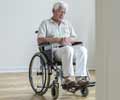Researchers highlight that surgeons can now remove a dangerous cholesteatoma in such a way that the facial nerve is not injured, surpassing a potential complication, facial paralysis.
In a first ever study conducted, researchers highlight that surgeons can now remove a dangerous cholesteatoma in such a way that the facial nerve is not injured. This study, which investigates facial nerve dehiscence when cholesteatoma is also present, attempts to describe where and how often the facial nerve is most commonly missing its bony, covering. This can provide surgeons with adequate knowledge, helping them prevent a potential complication, facial paralysis.
The facial nerve, the nerve responsible for moving essentially all of the muscles of the human face, takes an unusual route from the brain to the face. It travels directly through the temporal bone, and as such, it comes into close contact with the inner ear and balance organs which also reside in the temporal bone. In fact, sometimes the facial nerve can be seen directly in the floor of the ‘middle ear space,’ the space just behind the human ear drum. Usually the nerve has a bony covering over it that helps protect it from injury or infection, but sometimes this bony covering is missing. When this protective bone is gone, the nerve is said to be ‘dehiscent.’Unfortunately, when the nerve is dehiscent, it is much more vulnerable to a variety of disease processes that frequently affect the ear. Infection, trauma, and sometimes even surgery can all potentially damage the facial nerve, and a non-functioning nerve can lead to a devastating and often permanent facial paralysis.
One particular disease process, cholesteatoma, makes the ear and the facial nerve especially vulnerable to injury. Cholesteatoma is an abnormal pocket of trapped skin and tissue in the ear, usually just behind the eardrum. When this trapped skin cannot flake away from the underlying newly forming skin as it is supposed to, excessive debris and keratin can build up as the skin continues to grow. Over time, this trapped debris can become quite large, almost behaving like a small benign tumor, and it can erode into the ear bones and other structures. If the trapped debris grows large enough, it can even cause problems with hearing and balance. Indeed, cholesteatomas can also grow into the nearby facial nerve, causing facial paralysis, or they can erode the nerve’s bony covering, making it dehiscent. This is especially a problem when doctors perform surgery to remove the cholesteatoma, as the facial nerve is now especially vulnerable to injury.
Eligible patients were consecutively enrolled in a prospective database from 1985-2005. From the original database, ultimately 416 ears were identified in which cholesteatoma was diagnosed at the time of surgery. Facial nerve dehiscence was characterized as either present or absent in the tympanic and the mastoid segments of the nerve. Dehiscence in the tympanic segment was then further characterized using the oval window and cochleariform process as landmarks. The presence of cholesteatoma directly adherent to the nerve was noted as were any fistulae to either the cochlea or semi-circular canals. Statistical analysis included the chi-squared test of independence (£q2) to analyze the relationship between age and rate of dehiscence. The £q2 test was also used to analyze the relationship between dehiscence of the facial nerve and inner ear fistula.
Study patients averaged 28 years in age, ranging from 10 months to 81 years. Fifty-seven percent were male, 43 percent were female. A facial nerve dehiscence was found in 78 of the 416 patients (18.8 percent). The most common site of dehiscence centered above the oval window (a middle ear landmark), with 80 percent of dehiscent nerves involving this area. Patients age 18 and under were less likely to have facial nerve dehiscence than older patients. Also, dehiscence of the facial nerve was also found to be associated with inner ear fistulae. Both of these observations were shown to be statistically significant by the £q2 test.
Source: Newswise






